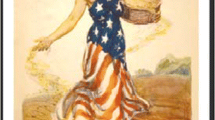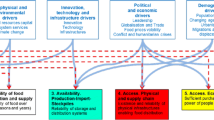Abstract
The disruptions that wracked food supply chains amid the COVID-19 pandemic were not exceptional circumstances so much as they were events that intensified and clarified the routine norms of a capitalist system of sustenance that operates in a state of permanent emergency. The capitalist food system is one that develops through temporary measures—acts that seek to patch structural weaknesses before they explode in ways that could destabilize the system itself. Looking via the lens of US animal agriculture, this concluding chapter asks if viewing the food system in this way might open up alternative ways of thinking about political agency in times of mundane crisis, highlighting the messy contingencies of capitalism’s own persistent efforts to foreclose the realizations of other, fuller visions of nourishment.
You have full access to this open access chapter, Download chapter PDF
Similar content being viewed by others
Keywords
The preceding chapters depict a world of food commodities beset by ubiquitous disruption, even as the fundamental conditions of an ever-colonizing capitalism change little over time. Moments of rupture and friction that would appear to unsettle capitalist hegemony paradoxically entrench it even deeper (Giles). Declarations of looming emergency become development tools to ensure food chains attract and accumulate yet more capital (Sippel). Constant disruptions to ecology and livelihood discipline agriculturalists to resigned acquiescence (Rickards and Hinkson). Invocations of crisis seek further investment in the status quo (Masco, 2017). As Victoria Stead and Kirstie Petrou demonstrate, elemental honorary titles like “essential” fall flat when they are emplaced onto the farmers, farm workers and food supply chain workers who sustain our lives. Rather than a stable essence to be protected, maintained and nurtured over time, the authors of this volume collectively paint a food system marked by what Melinda Cooper (2008, p. 20) has called a capitalist delirium restlessly defined by the cyclical “breakdown and recreation of whole worlds”. As Tomaso Ferrando and others argue, the disruptions that wracked food supply chains amid the COVID-19 pandemic were not exceptional circumstances so much as they were events that intensified and clarified the routine norms of a capitalist system of sustenance that operates in a state of permanent emergency.
Inspired by these chapters, my concluding suggestion is to consider the capitalist food system as one that develops through temporary measures (see Stead and Petrou)—and that perhaps agri-capitalism is itself best seen as a massive temporary measure. A temporary measure is an act that seeks to patch a structural weakness before it explodes in a way that could destabilize the system itself; temporary measures are, more simply, makeshift solutions to a problem. The sweeping and much-publicized shifts to trade and labour policy that tried to salve scarcity, wastage and livelihood ruination during the COVID-19 pandemic appear, in this light, as something of a ruse. As Henry and Morris illuminate, these rapid shifts in governance were not merely a reflection of exceptional circumstances. The management of any supply chain, they suggest, is one of unending adjustment as issues large and small erupt to the surface; even in “normal” times, the labour of supply chains is not characterized by frictionless execution but instead by constant patching. The spectacular quality of COVID-19 policy adjustments merely made governance through temporary measures more visible. What I find useful about focusing onto temporary measures is that it might open up alternative ways of thinking about political agency in times of mundane crisis. Seeing the food system as a patchwork of temporary measures helps us not only sense the contingent messiness of these processes but also allows us to question the idea that capitalist sustenance is directed by omniscient, rational agents. Appearing less like all-powerful planners, corporate financiers and international policymakers emerge in these chapters as fundamentally reactive: desperately trying to keep afloat capitalist food worlds.
I approach this volume, and its analyses of the non-transformational upheavals of COVID-19, through my own experiences working in US animal agribusinesses. A decade prior to this pandemic, I spent eight months shadowing managers across their activities in one of the world’s largest pork corporations—a network that annually births, raises and kills some 7,000,000 hogs for global distribution. These managers’ days consisted of tamping down endemic crises—their every moment of work was directed towards mending problems that stemmed from their own ambitions to confine millions of immunocompromised and genetically homogenous animals in a patch of land. Even at the corporation’s upper echelons, time was not primarily spent plotting future models and visions of increased capital accumulation. It was directed towards devising temporary measures to keep this biological experiment afloat (see Blanchette, 2020). At a moment when agri-food corporations project themselves as smoothly occupying and stitching together the entire planet, it is time to take more seriously the fragility and even the pathetic nature of how food firms maintain a hold on life (Lien, 2015; Blanchette, 2018).
At the same time, and as these chapters suggest, there is a certain recursive power that comes with governing through temporary measures. The five largest North American capitalist meat-production firms alone sickened 59,000 of their employees with COVID-19—and they have killed no fewer than 269 people since March 2020 (Hassan, 2021). By invoking the Defense Production Act—itself a temporary measure—in April 2020 to legally insulate these companies from prosecution, then-president Donald Trump declared these (largely migrant) workers sacrifices to national infrastructure. The perversity of this temporary measure, this most astonishing and latest temporary measure, is that it effectively excused all of the harmful temporary measures that preceded this state-sanctioned licence to kill. Consider that prior to the emergence of COVID-19, US animal agribusiness was a patchwork of slaughterhouse-line speed-limit exceptions, special rules put in place to accommodate growing animal herd sizes and that allowed select companies to strain human bodies to the point where debilitating repetitive-motion injuries were routine. As US confined animal feeding operations have grown in scale and concentration since the 1980s, they have been permitted to operate through special laws that exempt them from regulation under “normal” industrial rules governing air pollution and emissions standards (see Blanchette, 2019). Even animal breeding farms, with their erotic methods of artificial insemination that help increase productivity, had to pursue unique agricultural legal exceptions from state legislatures to keep them from running afoul of bestiality laws (Rosenberg, 2017). North American meat production has long developed by exceeding moral and legal norms and then pursuing temporary measures that enable it to continue unaltered. But the temporary measures put into place during COVID-19 make all these prior acts seem innocuous compared to the current fact that people were killed for corporate profits (see also Dickinson).
From where I write and live, in the United States, this history of agricultural capitalism has been a matter of ever-compounding brutalities that (for some) make the foundational horrors of that country, with its whitewashed settler-colonial family farms, seem like an object of nostalgic longing. Yet this is where I read the chapters of this volume as making a profound intervention. A sub-thread of these chapters is that the status quo of settler-productivist agriculture is itself the problem (see Donati, Altman and Markham). What sets this volume’s chapters apart is not simply their timely depictions of the even-further-destabilized capitalist food system on which so many depend. It is their refusal to play into the structural logic of temporary measures, insisting that agri-capitalism’s fundamental drive is its own continued reproduction through the suppression of indigenous and other lifeways and relations to land that promise the realization of other worlds. On this score, they remind me of a political philosophy articulated by the socialist-feminist theorist Silvia Federici (1998). Federici calls the rise of liberal capitalism—and its restless spread across natural and moral borders—a counter-revolution. She insists that the emergence of capitalism was not a historical break from European feudalism—not a new chapter in a linear progressive march forward in historical time—but instead a reactionary means of subduing ordinary peoples’ yearnings for new forms of equality and experimental sociality that threatened to unmake feudalism’s racial-patriarchal mooring (see also Robinson, 2021). What these chapters insist, not unlike Federici, is that capitalism is itself better seen as a massive temporary measure whose delirious disruptions continually block and misdirect the pursuit of fuller visions of nourishment throughout the food system. In so doing, they prod us to nurture ways of living and acting with the realization, as Di Haggerty declares in Kelly Donati’s chapter, with respect to the idea that settler private property and productivism is soon to be eclipsed, that “We’re only here temporarily”.
References
Blanchette, A. (2018). Nothing new. Journal for the Anthropology of North America, 21(2), 72–73.
Blanchette, A. (2019). Living waste and the labor of toxic health on American factory farms. Medical Anthropology Quarterly, 33(1), 80–100.
Blanchette, A. (2020). Porkopolis: American animality, standardized life, and the factory farm. Duke University Press.
Cooper, M. (2008). Life as surplus: Biotechnology and capitalism in the neoliberal era. University of Washington Press.
Federici, S. (1998). Caliban and the witch: Women, the body, and primitive accumulation. Autonomedia.
Hassan, A. (2021, October 28). Covid hit U.S. meat plants far harder than thought. The New York Times. https://www.nytimes.com/2021/10/28/world/meatpacking-workers-covid-cases-deaths.html
Lien, M. (2015). Becoming salmon: Aquaculture and the domestication of a fish. University of California Press.
Masco, J. (2017). The crisis in crisis. Current Anthropology, 58(S15), S65–S76.
Robinson, C. (2021). Black Marxism: The making of the black radical tradition (3rd ed.). University of North Carolina Press.
Rosenberg, G. (2017). How meat changed sex: The law of interspecies intimacy after industrial reproduction. GLQ, 23(4), 473–507.
Author information
Authors and Affiliations
Corresponding author
Editor information
Editors and Affiliations
Rights and permissions
Open Access This chapter is licensed under the terms of the Creative Commons Attribution 4.0 International License (http://creativecommons.org/licenses/by/4.0/), which permits use, sharing, adaptation, distribution and reproduction in any medium or format, as long as you give appropriate credit to the original author(s) and the source, provide a link to the Creative Commons license and indicate if changes were made.
The images or other third party material in this chapter are included in the chapter's Creative Commons license, unless indicated otherwise in a credit line to the material. If material is not included in the chapter's Creative Commons license and your intended use is not permitted by statutory regulation or exceeds the permitted use, you will need to obtain permission directly from the copyright holder.
Copyright information
© 2022 The Author(s)
About this chapter
Cite this chapter
Blanchette, A. (2022). Afterword: Temporary Measures. In: Stead, V., Hinkson, M. (eds) Beyond Global Food Supply Chains. Palgrave Macmillan, Singapore. https://doi.org/10.1007/978-981-19-3155-0_13
Download citation
DOI: https://doi.org/10.1007/978-981-19-3155-0_13
Published:
Publisher Name: Palgrave Macmillan, Singapore
Print ISBN: 978-981-19-3154-3
Online ISBN: 978-981-19-3155-0
eBook Packages: Social SciencesSocial Sciences (R0)




